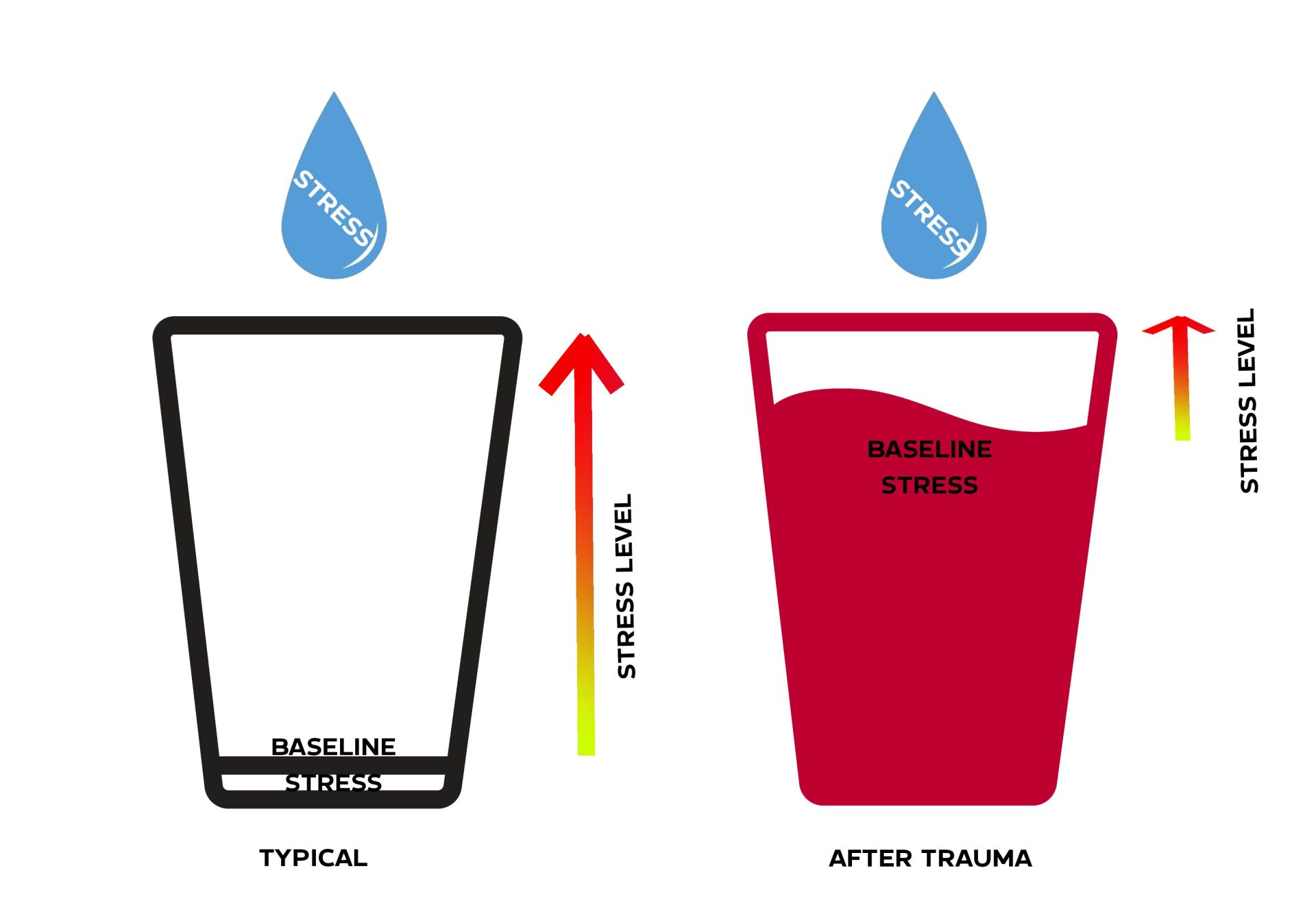Processing Trauma and Psychotherapy – The Who, How, What, and Why
Throughout life we are faced with challenges. Our hope is that we can move forward from these challenges. Some of these challenges are easy to overcome with a little bit of experience, training, or hard work. Others are much less so.
In some cases, we are faced with situations that cause significant physical, psychological, and emotional stress. These are known as “traumas.” These traumas can have a lasting impact on our happiness, our coping skills, and our psychological well being.
But what makes trauma so long lasting? Why do we find ourselves stuck, unable to move forward after a trauma and allowing it to affect our thoughts, dreams, relationships, and more?
The answer may have something to do with how our brain processes trauma and traumatic events. In this piece, our goal is to go into detail about trauma and trauma processing, help explain why trauma can be so challenging, and show some of the approaches used in psychotherapy to help process trauma. If you’re looking for a trauma therapist in NYC, please reach out to Flourish Psychology, today.
Who We Are: Flourish Psychology in Brooklyn, NY
Flourish Psychology is a boutique private practice located in Brooklyn. Our therapists specialize specifically in trauma, with expertise in different therapeutic approaches designed to help with trauma processing and trauma recovery.
Our work with patients that have post-traumatic stress disorder (PTSD) or past traumas that are impacting their life find that they are able to experience less distress and a brighter future after therapy. We encourage you to contact us today if you feel you’ve been struggling with any type of trauma.
Before We Begin, What Is PTSD and Trauma and What Does Trauma Do to the Mind and Body?
Post-Traumatic Stress Disorder (PTSD) is a severe psychological condition that arises after an individual experiences or witnesses something that they experience as a traumatic event. These events can include, but are no way limited to:
Sexual or Physical Assault
War and Combat
Child Abuse and Maltreatment
Living Through a Natural Disaster
Experiencing a Serious Accident, Like a Car Accident
Witnessing or Living Through a Terrorist Attack or Mass Shooting
It’s important to note, however, that there is no such thing as a “wrong trauma,” nor does someone have to have diagnosable PTSD for traumas to impact their life. For example, a person can find that a relatively small experience with bullying caused long term traumatic symptoms. Similarly, a person may experience trauma-related anxieties from panic attacks, getting fired from a job, or experiencing a health scare.
If you feel that you have traumas in your life, it doesn’t matter if they are as “severe” as others. They deserve to be addressed.
PTSD is the most severe of the trauma-related disorders. PTSD affects all individuals differently, but its hallmark is the persistent mental and emotional distress that follows exposure to trauma. PTSD manifests through a variety of symptoms that can significantly impact an individual’s daily life. These symptoms are generally categorized into four main types:
Intrusive Thoughts – These include flashbacks, nightmares, and distressing memories of the traumatic event.
Avoidance – Individuals may avoid places, people, and activities that remind them of the trauma.
Negative Alterations in Cognition and Mood – This includes persistent negative thoughts about oneself or the world, feelings of detachment from others, and a lack of interest in activities once enjoyed.
Alterations in Arousal and Reactivity – Symptoms in this category include being easily startled, feeling tense or “on edge,” difficulty sleeping, and experiencing angry outbursts.
With severe PTSD, a person may experience breaks with reality, where they feel as though they are transported back to the event and are reliving it, including all the fear of the experience.
Those that have experience traumas, but do not have PTSD, may still struggle with those traumas in many ways. The traumas may alter their behaviors, make it difficult for them to be present in their relationships.
In nearly all cases of trauma related mental health issues, a person is very, very quick to become anxious and stressed. Noises, behaviors, sudden movements, and other stress-causing activities can lead to far more severe anxiety and stress than the situation typically allows. This can make it very hard to manage the tasks that one needs to manage during the day.
The Filled Cup Theory
One way to understand the effects of trauma on a person’s stress and anxiety is to think
about our stress coping ability as cups:

Everyone has some total amount of stress they can naturally handle, like an empty cup. The more stress fills the cup, the more stress we experience. When the cup is empty, we may feel calm or relaxed, or some of us may feel a low level of stress but nothing we cannot handle. As it fills, you become more stressed, but it can take a lot of stress for us to feel overwhelmed and for our cup to spill over.
After someone has experienced trauma, it’s as though their cup always starts near full. Some people may be stressed and anxious all the time. Other people may still feel calm from day to day as they become used to the higher baseline, but they have very little room left in their cup. As a result, it takes much less total stress for the cup to fill up and spill over.
Our role as therapists is to find ways to help improve your stress-coping skills by working with you to empty your cup and make it easier for you to handle stress.
One approach to do that requires processing the traumatic event.
The Science of Unprocessed Trauma
There is evidence in the mental health community that people who experience traumatic events are often unable to *process* the trauma. The theory is that trauma is so stressful and so difficult emotionally and psychologically, that the brain has no idea how to adequately integrate traumatic events into its normal memory and emotional frameworks.
When a person experiences *any* event, the brain undergoes a complex process to encode and store the memory of that event. Under normal circumstances, memories are processed and integrated into our general memory network. This involves the coordination of several brain regions, primarily:
The Amygdala – Activates the body’s alarm system, responsible for emotional responses and detecting threats.
The Hippocampus – Involved in the formation of new memories and connecting them to emotions and sensory inputs.
The Prefrontal Cortex – Manages higher-order thinking, decision-making, and moderating social behavior.
During a traumatic event, the brain’s normal processing can be overwhelmed. The amygdala becomes hyperactive, flooding the brain with stress hormones such as cortisol and adrenaline. This heightened state of arousal can impair the functioning of the hippocampus and prefrontal cortex, leading to the fragmentation of memories. It can lead to:
Incomplete Processing – The traumatic memory remains in a raw, unprocessed state, causing it to intrude into consciousness through flashbacks, nightmares, and intrusive thoughts.
Dissociation – During the trauma, some individuals may mentally disconnect from the event to cope with the overwhelming stress, which can hinder the brain’s ability to fully process the memory.
Avoidance – Efforts to avoid reminders of the trauma prevent the individual from confronting and integrating the traumatic memory, perpetuating its fragmented state.
Negative Cognitions – Traumatic events can alter an individual’s beliefs about themselves, others, and the world. These negative cognitions can reinforce the persistence of unprocessed trauma.
As a result of all of these issues, the traumatic event is stored differently than non-traumatic events, often as disjointed sensory impressions or emotional reactions rather than coherent narratives.
In other words, while we may be able to remember the trauma and we may be affected by the trauma, our brains are still struggling to process and store it effectively.
How Can We Treat PTSD and Traumatic Stress? By Processing It
Given the theory that PTSD and related traumatic issues are caused by the inability to process traumatic events, the best way to treat these conditions is to help patients process them.
That is exactly what we find.
Many psychological treatments for PTSD are specifically designed to help patients process their traumas in a guided, calm setting under the supervision of a licensed therapist to help walk through the experience and give them the opportunity to process the event safely.

There are many ways that we can do this in therapy.
We will typically talk to you about the different options which may include:
Eye Movement Desensitization and Reprocessing
Eye Movement Desensitization and Reprocessing (EMDR) is a psychotherapeutic approach designed to help individuals process and integrate traumatic memories. Through EMDR, the patient is tasked with walking through the events of the trauma and trying to capture details in order to help process it. Key components of EMDR include:
Bilateral Stimulation – This involves guided eye movements, taps, or sounds that stimulate both sides of the brain. This bilateral stimulation is thought to facilitate the brain’s natural processing mechanisms, helping to integrate fragmented traumatic memories.
Desensitization – By repeatedly focusing on the traumatic memory while engaging in bilateral stimulation, the emotional intensity associated with the memory is reduced, making it less distressing.
Reprocessing – EMDR encourages the re-evaluation and re-framing of traumatic memories, leading to more adaptive understandings and beliefs about the trauma.
Because thinking about a traumatic event can be stressful, our Brooklyn therapists work with you to help you relax and stay in the moment without feeling overwhelmed.
EMDR is considered one of the most effective psychological techniques for processing trauma and reducing some of the symptoms of PTSD.
Cognitive Behavioral Therapy
Cognitive Behavioral Therapy (CBT) is a structured, time-limited therapy that focuses on the relationship between thoughts, emotions, and behaviors. CBT, as a technique, is not limited to trauma. It is considered the premiere approach for addressing a variety of mental health conditions, including anxiety and depression. Yet it is also effective for processing trauma as well.
The CBT techniques that are involved in processing trauma include:
Cognitive Restructuring – Identifying and challenging distorted or maladaptive thoughts related to the trauma. By altering these negative thought patterns, individuals can reduce the emotional impact of the trauma.
Exposure Techniques – Gradually confronting trauma-related memories and situations in a controlled manner to reduce avoidance and desensitize the individual to the traumatic stimuli.
Skills Training – Developing coping strategies and skills to manage stress and anxiety, improving overall resilience and emotional regulation.
Cognitive behavioral therapy is also useful because it can help some of the other issues related to living through traumas, such as anxiety and depression. It is a broad but highly effective treatment that is supported by countless studies.
Art Therapy
Art therapy is, as the name implies, therapy that takes place through art. It, like cognitive behavioral therapy, is considered highly effective for addressing traumas, specifically, due to the way that it allows people to work through traumas in a slow, deliberate, and controlled manner.
Art therapy aids trauma processing through:
Non-Verbal Expression – Art provides an alternative means of expression for those who may struggle to articulate their trauma verbally. It allows individuals to externalize and explore their feelings and memories in a safe and controlled environment.
Symbolic Processing – Creating art can help individuals symbolize and make sense of their trauma, leading to new insights and perspectives.
Emotional Release – The act of creating art can be therapeutic in itself, providing an outlet for emotions and reducing stress.
Art therapists also undergo very specific training, studying art therapy extensively and how to work with patients in order to process their traumas.
Trauma-Focused Cognitive Processing Therapy
Trauma-Focused Cognitive Processing Therapy (CPT) is a specialized form of CBT specifically designed for trauma survivors. It focuses on:
Challenging Trauma-Related Beliefs – Helping individuals identify and confront maladaptive beliefs and interpretations related to the trauma, such as self-blame or mistrust of others.
Narrative Writing – Encouraging individuals to write detailed accounts of their traumatic experiences, which can help organize fragmented memories and promote emotional processing.
Cognitive Restructuring – Similar to general CBT, CPT involves restructuring negative thoughts and beliefs to foster more adaptive thinking patterns.
CPT allows the therapist and patient to use CBT-related strategies that have been specifically altered to address trauma in a person’s past, and help them process it in a careful, effective way.
Regain Control of Your Life – Processing Trauma with Flourish Psychology
Processing trauma is not the only way to address PTSD and other trauma-related disorders, but it is one that is backed by evidence and an effective choice for many individuals. You and your therapist will work together to determine if EMDR, CBT, art therapy, or another treatment is the best course for you, and then work together to
make sure that you’re getting the help you need.
But when it is the right choice, these therapies are a very effective tool for addressing trauma and overcoming it – helping to empty your cup more and improve your stress coping ability.
Flourish Psychology, as a private psychotherapy practice in NYC, has therapists that take their time and make sure that you’re getting the help you need. We work with patients that experience trauma, but we also are there for you afterwards – helping you get what you need to put your life back together. If you are looking for help addressing your traumas, please contact Flourish Psychology, today.



